A Father's Support
- sulla80

- Oct 9, 2020
- 6 min read
Updated: Oct 26
The drachms of Cappadocia are the subject of today's post. I have three drachms of Ariarathes IX dated to regnal years A, B, and Δ. Their portraits could hardly be more different: a boy-king, a heavier head from a different hand, and two years later the unmistakable features of Mithridates VI. Read in isolation the coins seem inconsistent; read against Otto Mørkholm’s reconstruction of Cappadocia’s coinage they narrate a single political arc.
Die-links, hoard evidence, and epigraphic analysis relocate the so-called “Ariarathes V” style to the first phase of the reign of Ariarathes IX and explain the later coins with the features of Mithridates VI as deliberate propaganda. Together, the three coins document the seizure, loss, and re-consolidation of minting authority during the brief, violent interlude between the murders of Ariarathes VII and Rome’s imposition of Ariobarzanes I.
A Tangled Family Network
Laodice, the daughter of Mithridates V of Pontus and sister to Mithridates VI, married Ariarathes VI of Cappadocia. Their children were daughter, Nysa, and two sons, Ariarathes VII and Ariarathes VIII. Ariarathes VI was assassinated by Gordius, a Cappadocian nobleman and traitor. The elder son, Ariarathes VII ruled and raised an army to oppose Gordius, the assassin of his father and henchman of Mithridates VI.
By Justin's account, Mithridates "killed his nephew, after drawing him aside from his friends as if to confer with him secretly, in the sight of both armies", circa 100BC.
Mithridates then placed his eight-year-old son on the Cappadocian throne as Ariarathes IX (Eusebes Philopator).
"When the young Ariarthes [VII] understood his intention, he expressed great indignation that the murderer of his father should be recalled from banishment, especially by his uncle [Mithridates], and assembled a great army. Mithridates, after bringing into the field eighty thousand foot, ten thousand horse, and six hundred chariots armed with scythes, (while Ariarathes [VII], by the aid of the neighboring princes, had no less a force), fearing the uncertain event of a battle, turned his thoughts to treachery..."-Justine, Epitome, XXXVIII.1To control Cappadocia, Mithridates then put his eight year old son on the throne under the name of Ariarathes IX. A faction of Cappadocians rebelled supporting the more justified heir, Ariarathes VIII. He briefly contested power but soon died from illness.
"The Cappadocians, however, being harassed by the cruelty and licentiousness of their rulers, revolted from Mithridates, and sent for the brother of their king, who was also called Ariarathes, from Asia where he was being educated. Upon this prince Mithridates again made war, defeated him, and drove him from Cappadocia; and not long after the young man died of a disease brought on by anxiety."
-Justin, Epitome, XXXVIII.2.1Roman intervention, led by Lucius Cornelius Sulla, forced Ariarathes IX to resign; the Cappadocians chose Ariobarzanes I Philoromaios (friend of Rome).
Two cities dominate the geography of this story: Mazaca (Eusebeia) and Tyana, the likely sites of Cappadocia’s two royal mints.
Ariarathes VII
Eldest son of Ariarathes VI and Mithridate's sister Laodice:

Kings of Cappadocia, Ariarathes VII Philometor (mother loving), circa 112/110-100 BC., AR drachm, year 1 = 111 (?) Obv: Diademed head of Ariarathes VII to right Rev: BAΣΙΛΕΩΣ / APIAPAΘOY / ΦΙΛOMHTOPOΣ , Athena standing left, holding Nike on her extended right hand and spear and shield with her left; inner left, ΓΛI; in exergue, [A] (? date)
The legends can be a bit tricky to read - with the two vertical legends being the same (ARIARATHES, BASILEOS - King Ariarathes) across multiple rulers and the horizontal legend on the bottom is identifying - [ΦΙΛ]OMETOROS or "Mother Loving" identifying Ariarathes VII in this example:

Ariarathes IX - First Portrait
Ariarathes IX, the young son of Mithridates VI of Pontus. This is the “Ariarathes V” style that Mørkholm reassigns to Ariarathes IX on die-link evidence and hoard wear. The portrait’s fresh, non-Pontic portrait fits for a child ruler before the intervention by Mithridates VI.
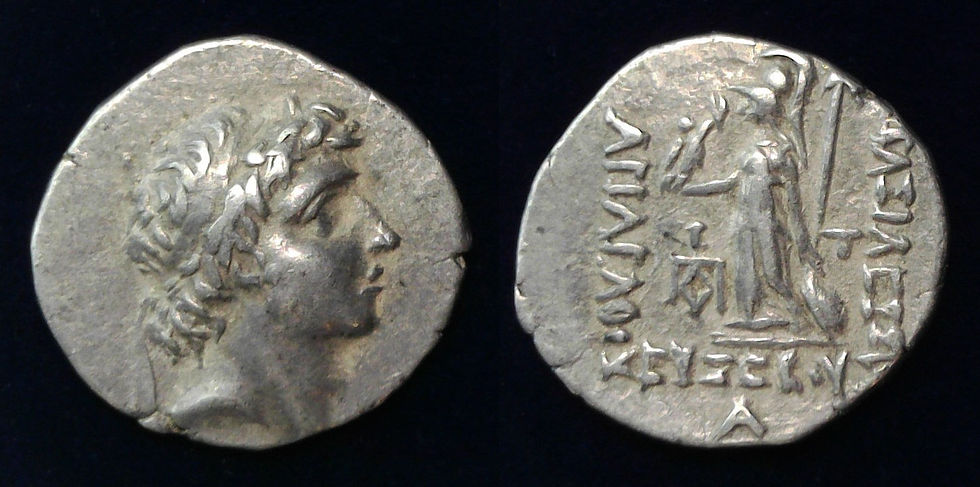
Kings of Cappadocia, Ariarathes IX Eusebes Philopator, circa 100-85 BC, AR Drachm, Series I
Obv: Diademed head right
Rev: BAΣΙΛΕΩΣ APIAPAΘOY EYΣEBOYΣ, Athena Nikephoros standing left; monogram to inner left, T to right; A (date) in exergue
Ref: Simonetta 6 (Ariarathes V); Mørkholm Series 1 #3 obv 1(?)
Mørkholm proposes that two mints:
Mint A (≈ Mazaca/Eusebeia): strikes Series I for Ariarathes IX from year A onward with portraits youthful.
Mint B (≈ Tyana): initially strikes for Ariarathes VIII (legend ΕΠΙΦΑΝΟΥΣ). During Ariarathes IX’s year B, Ariarathes IX seizes Mint B and issues there briefly (Series II), often using obverses prepared for VIII. This explains the different hand and mixed portrait styles.
Exergual letters function as regnal years (A, B, Γ, Δ, Ε). On Series II drachms the letter B is frequently blundered and can resemble E or K; comparison with letter forms in the reverse legend shows they are degraded B’s, not different years.
Ariarathes VIII
Here are two coins from Mint B of Ariarathes VIII with legend EΠIΦANOY on the reverse. Mørkholm isolates a small but distinct group for Ariarathes VIII with reverse legend ΒΑΣΙΛΕΩΣ ΑΡΙΑΡΑΘΟΥ ΕΠΙΦΑΝΟΥΣ and field letters linking the series to Mint B. Obverse style and a shared die with Ariarathes IX Series II clinch the attribution to VIII, not VI as assigned by Simonetta. Morkholm & Simonetta had a vigorous debate in the literature: see my post on Morkholm and Simonetta.

Kings of Cappadocia, Ariarathes VIII Eusebes Epiphanes, AR Drachm, dated RY 2 = 99/8 BC, Mint B
Obv: Diademed head right
Rev: ΒΑΣΙΛΕΩΣ ΑΡΙΑΡΑΘOV EΠIΦANOYΣ, Athena Nikephoros standing left, with spear and shield; T to inner left; B (date) in exergue
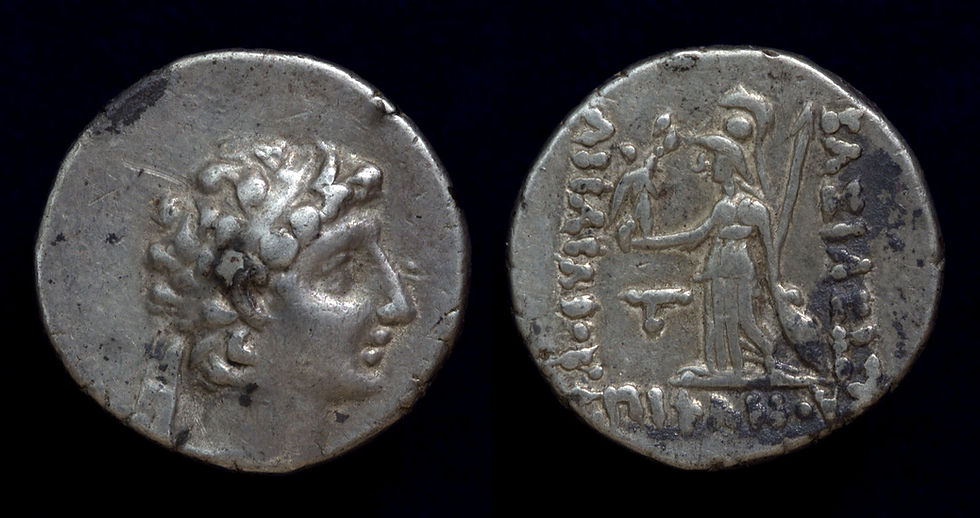
Kings of Cappadocia, Ariarathes VIII Eusebes Epiphanes, AR Drachm, dated RY ?, Mint B
Obv: Diademed head right
Rev: ΒΑΣΙΛΕΩΣ ΑΡΙΑΡΑΘOV EΠIΦANOYΣ, Athena Nikephoros standing left, with spear and shield; T to inner left; date (off-flan or not present)
Ariarathes IX - Second Portrait
The rebellion was quelled before long and the rival, Ariarathes VIII, was expelled and died of disease shortly after. And here is the second portrait on a coin from Mint B (second regnal year) attributed by Mørkholm to Ariarathes IX after he gained control of this mint and before he closed it. The blundered B in the exergue - often mistaken for E or K - is a hallmark of the series; the fabric and field letters match issues of Ariarathes VIII, showing continuity of the mint shop even as political control changed. Note that (EΠIΦANOYΣ is replaced by YΣEBOYΣ).
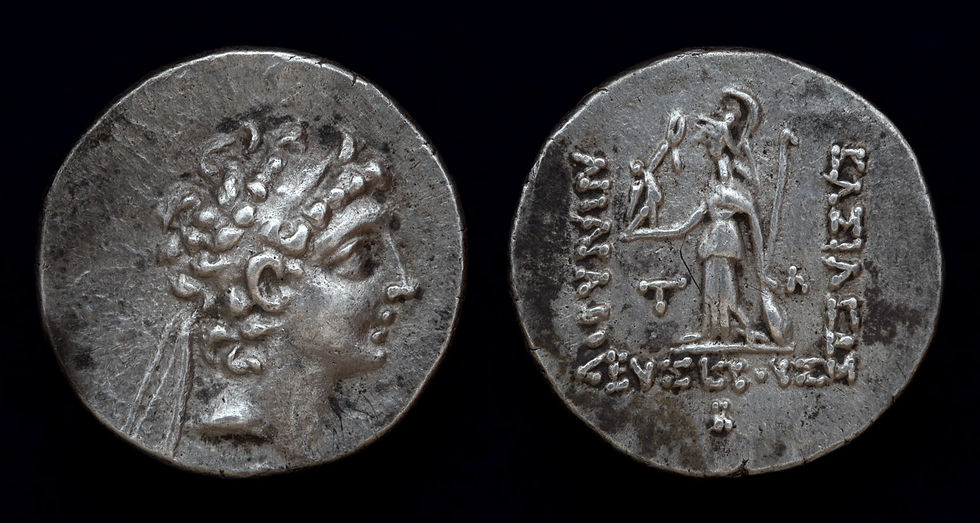
Kings of Cappadocia, Mint B, Ariarathes IX Eusebes, 100-95 BC, dated RY 2=99/8 BC, AR drachm Series II
Obv: Diademed head of Ariarathes to right / BAΣΙΛΕΩΣ APIAPAΘOY EYΣEBOYΣ
Rev: Athena Nikephoros standing left, to inner left, T, to inner right, Λ, B (date) in exergue
Ariarathes IX - Third Portrait
By year 4 the portrait is explicit propaganda. Mørkholm reads this portrait, which incorporates features of Mithridates VI with those of his son, as sending a clear message to the Cappadocians that under his son’s reign, they are ruled by Mithridates VI.
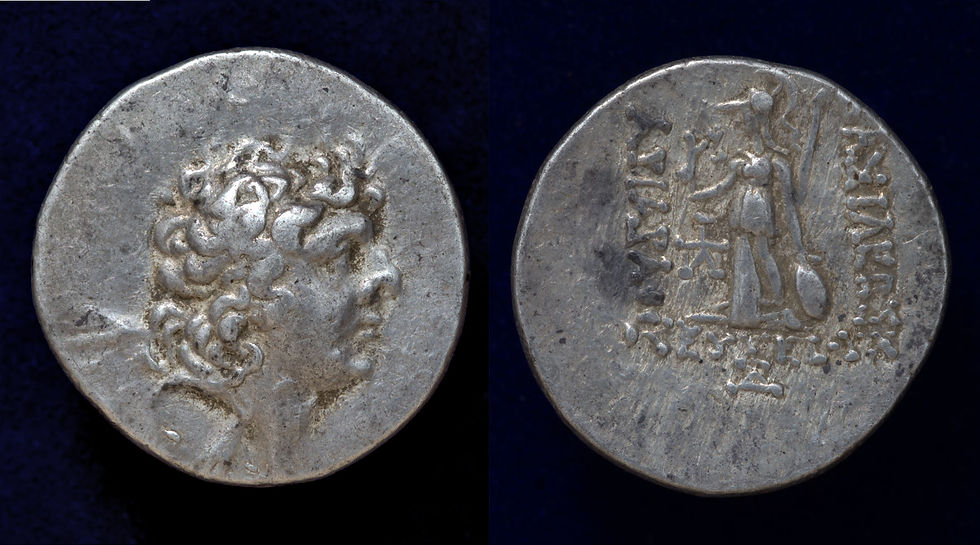
Kings of Cappadocia, Ariarathes IX Eusebes Philopator, circa 100-85 BC. AR Drachm, Mint A (Eusebeia-Mazaka), Dated RY 4 (97/6 BC)
Obv: Diademed head right, with the features of Mithradates VI of Pontos
Rev: BAΣΙΛΕΩΣ APIAPAΘOY EYΣEBOY, Athena Nikephoros standing left; monogram to inner left, Δ (date) in exergue

This next coin which appears to be from year 5 (E) has a very strong resemblance portraits of Mithridates VI on other coins.


B.C. | Regnal year | Mint A (Mazaca/Eusebeia) | Mint B (Tyana) |
99 | A | Ariarathes IX, Series I → Coin 1 | Ariarathes VIII (issues 1–5) |
98 | B | Series I continues | Ariarathes IX, Series II → Coin 2 |
97 | Γ | Series I, later issues | Ariarathes IX, Series II (small issue) |
96 | Δ | Late Series I (Mithridatic bust) → Coin 3 | tiny issue |
95 | Ε | Series I (final) | — |
Ariobarzanes
To conclude the story, here is a drachm from Capadoccia of Ariobarzanes who was chosen by the Cappadocian people as King after the Romans deposed Ariarathes IX. This coin has a particularly elegant and expressive portrait:

Kings of Cappadocia, Ariobarzanes I Philoromaios, 96-63 BC, AR Drachm, 17mm, 3.98 g, dated RY 25 (71/0 BC)
Obv: Diademed head right
Rev: Athena Nikephoros standing left; monogram in inner left field, KE (date) in exergue.
Conclusion
These drachms provide a compressed political history of Cappadocia between c. 99 and 96 BCE. They chart the installation of a child-king, a struggle for control of a second mint, and the ultimate declaration - in the portrait - that Mithridates VI ruled Cappadocia through his son. The die-links and hoards not only date the coins; they unveil the story of power struggles in Cappadocia with Pontus - deadly power struggles between related family members.
Notes & References
these notes were extensively revised from the 2020 original with the addition of the fourth coin of Ariarathes IX on 26-Oct-2025.
Otto Mørkholm, “The Coinages of Ariarathes VIII and Ariarathes IX of Cappadocia,” Numismatic Chronicle (1964), plates 30–33.
Justin (Justinus), Epitome of Pompeius Trogus 38.1–3 (Ariarathes VII murdered; brief rule and death of Ariarathes VIII).
Strabo 12.2.7 Mazaca/Eusebeia and Tyana as the principal Cappadocian urban centers; Mørkholm 1964 cautiously aligns these with Mints A and B.
Margaret Thompson, The New Style Silver Coinage of Athens (1961), for hoard evidence referenced by Mørkholm; and B. Simonetta (e.g., RIN 1958; NC 1961) for the earlier attributions discussed and revised.

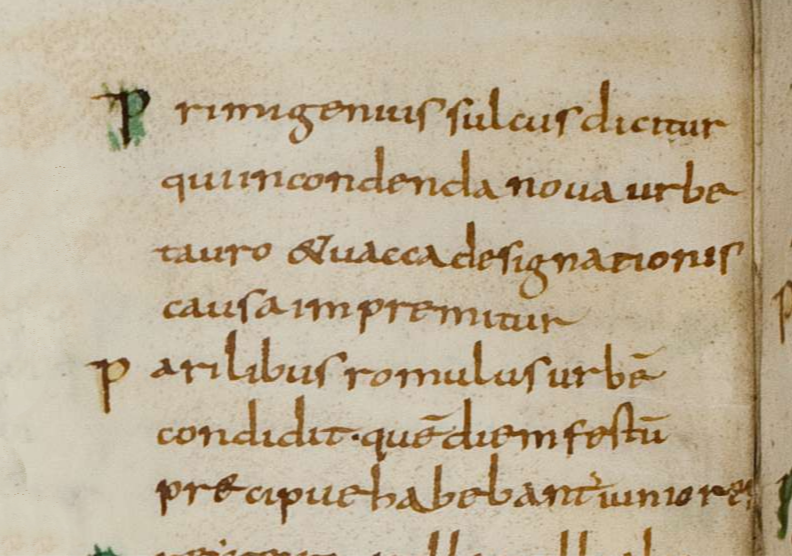

Comments